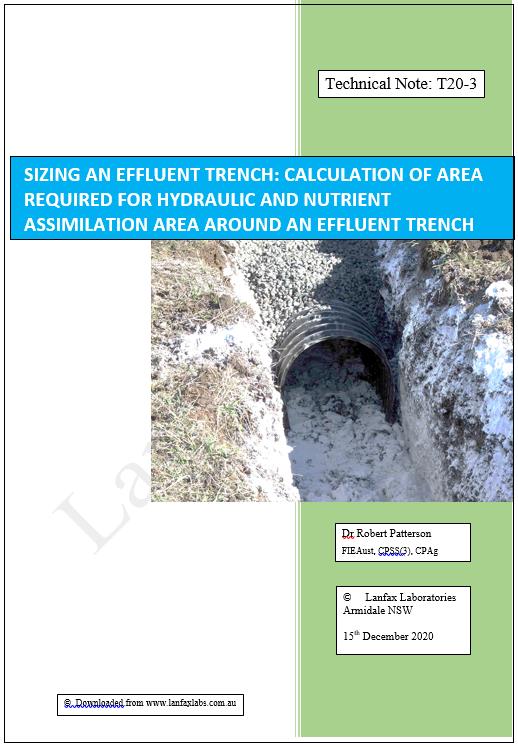Sizing an Effluent Trench:
Calculation of Area Required for Hydraulic and Nutrient Assimilation Area |
Around an Effluent Trench
Introduction
When on-site wastewater systems are planned and constructed, the effluent must be returned to the environment in a sustainable way for the two major components, water and nutrients. The calculation of the hydraulic load is modelled using monthly rainfall, evapotranspiration, deep drainage and soil water storage for the locality and specific soil profile. The nutrients are assimilated by plants, soil biota and immobilisation mechanisms in the soil. An understanding of each of these components will assist in better planning for longevity of the soil system. See Rainfall Statistics for detail.
 This
document discusses the following topics:
This
document discusses the following topics:
2. Water in the soil environment
3. Capillary forces in a soil profile
4. Water movement in trenches
4.1 Basic water movement
4.2 Safety factor in design loading
4.3 Sidewall or no sidewall allowance
4.4 Variables in sidewall and bottom area calculations
| 4.5 Water balance and rainfall
4.6 Permeability and DLR5. Assimilation Area Calculation
6. Nutrient Assimilation around a Trench
7. Conclusion
The movement of water away from a trench is dictated by the saturated hydraulic capacity of the particular soil, the varying characteristics of the soil horizons, the chemical interactions between effluent and soil, the effluent loading rate and climatic factors affecting rainfall and evapotranspiration.
That only bottom area of a trench system, as indicated in the Standard AS/NZS 1547:2012, can be used to develop an appropriate design loading rate is one that jumps from indicative permeability to long term acceptance rate to design loading rate without rationale. That sidewalls do not play in the everyday loss of water from a trench is contradictory within the Standard and defies common sense and observation. That the Standard is ultra-conservative is an understatement and as such imposes significant additional and unnecessary installation and maintenance costs for no apparent reason.
The NSW Guidelines offer the legislators a tool to significantly restrict the use of the natural soil for the treatment and ultimate fate of domestic septic tank effluent, joining with the Standard to increase the area required for treatment. Neither document takes a decisive role in using science to meet the practical challenges and opportunities for low energy return of wastewater to the environment.
Throughout this document, the anomalies of both the Standard and the NSW Guidelines with the science of effluent interactions with soils are compared and contrasted with what occurs in the field.